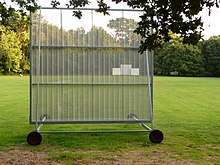Sight screen

A sight screen in cricket is an apparatus, often comprising wooden slats, cloth or canvas on a large frame made of wood or another material, that is positioned on the cricket field. Typically, two sight screens are actively deployed on a field during live play, each positioned a short distance behind the boundary rope.[1][2] From the perspective of a batsman facing a delivery on the pitch, one sight screen is directly past the bowler's end, or at the straight boundary, while the other is directly behind the batsman, or at the long stop boundary.[3]
The function of the sight screen, which is usually completely black or white in color, is to offer the batsman a clean view of the bowler's delivery, such that distractions including spectators do not disturb the batsman. In limited overs matches such as One Day Internationals or Twenty20 Internationals, which are usually played with a white ball, the sight screen is usually black, or otherwise dark. In Test matches, in which a red or pink ball is used for play, the sight screen is usually white.[4]
Sight screens have, on occasion, not been large enough to entirely cover the critical area for the batsman to effectively view the bowler's delivery. Groundskeepers may make such decisions to allow for more spectators into the ground. Similarly, sight screens have in the past been used for display advertising, compromising their darkness (in limited overs matches) or whiteness (in Tests). On such occasions, batting sides have often expressed frustration, especially if particular batsmen experienced difficulty in effectively seeing the ball during a fast bowler's delivery. Jacques Kallis succumbed to an Andrew Flintoff full toss at Edgbaston Cricket Ground under these circumstances during South Africa's tour of England in 2008, an incident that triggered much debate at the time.[5] In today's game, advertising in ICC-sanctioned Test matches is only allowed on the sight screen behind the wicket-keeper, so that it must be removed every other over and then replaced again after the next over is played from the other end.[6]
The sight screen serves a similar function to the batter's eye in baseball.[7]
See also
References
- ↑ B.R. In the blink of an eye. The Economist.
- ↑ ESPNcricinfo Staff.For good measure. ESPNcricinfo.
- ↑ Alec Waugh. Talking point for cricket. Sports Illustrated.
- ↑ Peter English. Bulb breaks on nights in whites. ESPNcricinfo.
- ↑ Angus Fraser. Kallis exposes official blind spot. The Independent.
- ↑ Test Match Playing Conditions. ESPNcricinfo / International Cricket Council.
- ↑ Dan Holmes. Origins behind some puzzling baseball terms. Wahoo Sam.